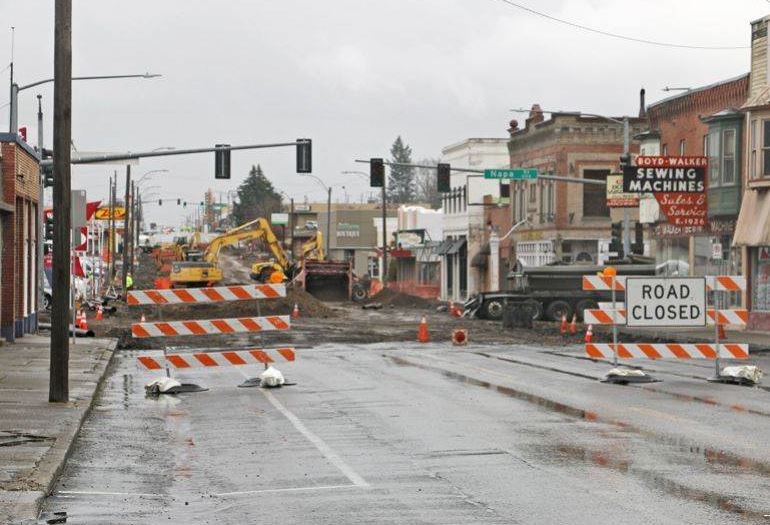City’s economic development effort gains momentum - Projects in East Sprague, U District show promise
Thursday, April 13, 2017

(as reported in the Journal of Business by LeAnn Bjerken)
Officials with the city of Spokane say its economic development program is starting to have some noticeable impacts this season, with several key projects starting or expected to start construction soon.
City planner, and team lead for the program, Andrew Worlock, says although the program was created through a City Council resolution two years ago, its effects have gone mostly unnoticed until now.
“We’d had incentives and been working within target areas before,” he says. “But last year was the first year we were able to really formalize the program around that work, and as a result, each of our target districts is seeing a fair bit of activity right now.”
Worlock says the program was specifically designed to encourage development and to jump-start investment in business and job opportunities here.
“We recognized that trying to achieve economic development over a city this large, with few resources, would be difficult,” he says. “So it made sense to focus our attention and resources on specific, target investment areas.”
He says the program currently has six target areas, those being downtown, East Sprague, the University District, Hillyard, Kendall Yards, and the West Plains.
Worlock says target investment areas are chosen by looking at four main criteria: community opportunity and support, what the city has done or hopes to do in areas of infrastructure and capital investments, incentives available, and how much continued resources and staff support would be needed.
“These areas are all a bit different in terms of goals and opportunities, but this approach allows us to tailor incentives to each,” says Worlock. “We’re able to recognize those differences, and bring them the right incentives, so that development is supported.”
Worlock’s economic development team includes four people, three of whom are professional planners, while the fourth is a project team assistant.
Each team member is assigned target areas, watching each for upcoming proposed projects and connecting interested developers with incentives that might help them make those projects a reality.
“We help steer potential projects toward areas of the city that will realize the most benefit from incentives,” he says. “We also work with stakeholder groups in each area and help with access to state or federally funded grants for things like brownfield assessments and planning.”
Worlock says he is the representative for the downtown and U District areas, while Melissa Owen works with the East Sprague and Hillyard areas, and Boris Borisov works with Kendall Yards and the West Plains. He says Teri Stripes is the team’s brownfields expert and also helps support other staff, as well as tracking projects taking place on the South Hill.
Worlock says team members also are responsible for tracking and recording which incentives have been used within their target areas, and what impact they’ve had.
“We use that data to compile an annual report, which is presented to city council,” says Worlock. “At that time, we also present any recommendations for changes to target areas.”
So far, he says the biggest challenge for his team has been getting the word out about the incentive program, and the investments the city is making in these key areas.
“Certain incentives have their own internal requirements,” he says. “There are also incentives available for what we call projects of citywide significance, those being larger dollar value projects that will likely have significant benefit to the public.”
Worlock says incentives can include historic preservation, home improvement, and multifamily tax exemptions; waivers or deferment of certain fees associated with right of way, traffic impacts, and water and sewer connections; commercial rate clarification for existing buildings; tax increment financing; brownfield remediation or redevelopment; blight remediation; and an urban utility installation program.
Worlock says the two target investment areas that have perhaps seen the most activity recently are East Sprague and the University District.
“The East Sprague community in particular has really come together on plans for improvements, infrastructure support, revitalization efforts, and neighborhood planning,” he says.
Worlock says Mayor David Condon earlier this month kicked off the start of construction for some East Sprague improvements, involving a major streetscape project that’s being done in cooperation with the East Sprague Business Association.
Other projects in the area include the start of construction on the University District Gateway Bridge and the upcoming continuation of the extension of Martin Luther King Jr. Way, as well as a Division Street corridor project.
“East Sprague and the U District are closely connected in some ways, and the projects we’re working on in both will have benefits for each,” says Worlock. “Improvements on Sprague will revitalize the area and increase business development, the new bridge will bring more pedestrian and bicycle visitor traffic through, and the MLK Jr. Way connection will provide additional access through the U District and beyond.”
Looking ahead, Worlock says his team is already working on how best to record the impact of the upcoming projects, once they’ve completed construction.
“We’ll be looking at several factors including changes in property values and number of new businesses created,” he says. “That information can then be used to make recommendations for changes to incentive programs or target investment areas, and help us to outline our future goals for each district.”
- See more at: https://www.spokanejournal.com/local-news/citys-economic-development-effort-gains-momentum/#sthash.oHuXh6AH.dpuf